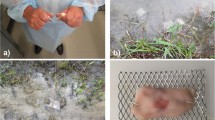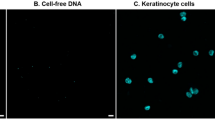Summary
In 3 series paired volunteers were asked to gently scratch each other with the fingernails to produce superficial abrasions only of the stratum corneum. In a 4th series scratch marks were produced in the skin of cadavers but additionally including the deeper epidermal layers. Debris was removed using a thorough technique in series 1 and 2 and a careful technique in series 3. After DNA extraction, the debris was typed using the STR systems HUMACTBP2 (SE33), HUMTH01 (TC11) and HUMVWFA31 (VWA). In the material obtained from series 1 (i.e. scratching with no prior cleaning of the nails) and series 2 (i.e. cleaning of the nails prior to the experiment) the debris was removed with a sharp instrument and only the DNA pattern of the person who carried out the scratching could be detected. In the 3rd series extraneous material was removed very carefully from under the fingernails to avoid contamination with DNA from the nails. In 71% of these cases DNA patterns of the person who had been scratched or mixed DNA patterns of both persons could be detected. In the experiments with postmortem skin the DNA pattern of the cadaver could be detected in all cases. These results show that in crime cases where the perpetrator has been scratched by the victim, sufficient material can be obtained from under the fingernails for DNA typing if removal of the particles is carried out with sufficient care.
Zusammeufassung
In 3 Versuchsreihen erzeugten freiwillige Probanden jeweils gegenseitig oberflächliche Kratzverletzungen, die ausschließlich auf das Stratum corneum der Epidermis beschrdnkt waren. In einer vierten Versuchsreihe wurden Kratzverletzungen auch der tieferen Epidermisschichten an Leichenhaut hervorgerufen. Die Epithelschüppchen unter den Fingerndgeln wurden mit verschiedenen Techniken asserviert and nach DNA-Extraktion unter Anwendung der STR-Systeme HUMACTBP2 (SE33), HUMTH01 (TC11) und HUMVWFA31 (VWA) individualisiert. In den beiden ersten Versuchsreihen (1. Kratzen mit zuvor ungereinigten Fingernägeln, 2. Asservieren der Epithelschüppchen mit scharfem Instrument und intensiver Reinigung vor und nach dem Kratzen) konnten lediglich Merkmale des Kratzenden festgestellt werden. Da bei der dritten Versuchsreihe besonderer Wert auf eine vorsichtige Asservierung der Epithelpartikel gelegt wurde, ohne dabei gleichzeitig Schüppchen der Fingernägel abzukratzen, gelang es in 71% der Fälle, die DNA des Gekratzten oder ein Mischmuster des Kratzenden und Gekratzten darzustellen. Die Versuche an Leichenhaut ergaben in allen Fällen das Muster des Verstorbenen. Die Ergebnisse belegen, daß bei entsprechenden Spurenfällen die Untersuchung eines sorgfältig präparierten Fingernagelschmutzes in einem hohen Prozentsatz erfolgreich sein kann und somit zur Identifizierung eines Tatverdächtigen geeignet ist.
Similar content being viewed by others
References
Allen RC, Graves G, Budowle B (1989) Polymerase chain reaction amplification products separated on rehydratable polyacrylamide gels and stained with silver. BioTechniques 7:736–744
Brinkmann B (1992) The use of STRs in stain analysis. In: Proceedings from the third international symposium on human identification 1992. Promega Corporation, Madison, USA, pp 357–374
Brinkmann B, Rand S, Wiegand P (1991) Population and family data of RFLP's using selected single- and multi-locus systems. Int J Leg Med 104:81–86
Budowle B, Chakraborty R, Giusti AM, Eisenberg AJ, Allen RC (1991) Analysis of the variable number of tandem repeats locus D1S80 by the polymerase chain reaction followed by high resolution polyacrylamide gel electrophoresis. Am J Hum Genet 48:137–144
Edwards A, Hammond HA, Jin L, Caskey CT, Chakraborty R (1992) Genetic variation at five trimeric and tetrameric tandem repeat loci in four human population groups. Genomics 12:241–253
Kimpton C, Walton A, Gill P (1992) A further tetranucleotide repeat polymorphism in the vWF gene. Hum Mol Genet 1:287
Polymeropoulos MH, Rath DS, Xiao H, Merril CR (1992) Tetranucleotide repeat polymorphism at the human beta-actin related pseudogene H-beta-Ac-psi-2 (ACTBP2). Nucleic Acids Res 20:1432
Walsh PS, Metzger DA, Higuchi R (1991) Chelex-100 as a medium for simple extraction of DNA for PCR-based typing from forensic material. BioTechniques 10:506–513
Wiegand P, Budowle B, Rand S, Brinkmann B (1993) Forensic validation of the STR systems TC 11 and SE 33. Int J Legal Med 105:315–320
Author information
Authors and Affiliations
Rights and permissions
About this article
Cite this article
Wiegand, P., Bajanowski, T. & Brinkmann, B. DNA typing of debris from fingernails. Int J Leg Med 106, 81–83 (1993). https://doi.org/10.1007/BF01225045
Received:
Revised:
Issue Date:
DOI: https://doi.org/10.1007/BF01225045




